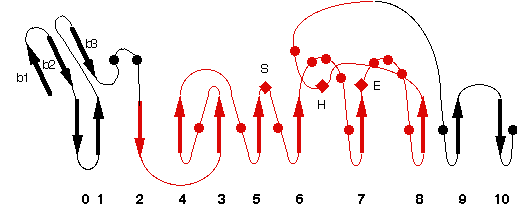1P0P
Name : Crystal structure of soman-aged human butyrylcholinesterase in complex with the substrate analog butyrylthiocholine
Revelation date : 05-Aug-2003
Family : BCHE
Gene_locus : human-BCHE
PDB file : ESTHER: header of PDB entry RCSB: Full entry
Comment
Ligand :
References (1)
| Title : Crystal structure of human butyrylcholinesterase and of its complexes with substrate and products - Nicolet_2003_J.Biol.Chem_278_41141 |
| Author(s) : Nicolet Y , Lockridge O , Masson P , Fontecilla-Camps JC , Nachon F |
| Ref : Journal of Biological Chemistry , 278 :41141 , 2003 |
| Abstract : Nicolet_2003_J.Biol.Chem_278_41141 |
| ESTHER : Nicolet_2003_J.Biol.Chem_278_41141 |
| PubMedSearch : Nicolet_2003_J.Biol.Chem_278_41141 |
| PubMedID: 12869558 |
| Gene_locus related to this paper: human-BCHE |
Representative scheme of Prolylcarboxypeptidase structure and an image from PDBsum server

